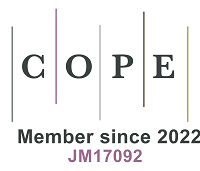REFERENCES
1. United Nation Environment Programme - Stockholm Convention. All POPs listed in the stockholm convention. Available from: http://www.pops.int/TheConvention/ThePOPs/All POPs/tabid/2509/Default.aspx [Last accessed on 26 Sep 2022].
2. Blum A, Behl M, Birnbaum L, et al. Organophosphate ester flame retardants: are they a regrettable substitution for polybrominated diphenyl ethers? Environ Sci Technol Lett 2019;6:638-49.
3. Yao Y, Li M, Pan L, et al. Exposure to organophosphate ester flame retardants and plasticizers during pregnancy: thyroid endocrine disruption and mediation role of oxidative stress. Environ Int 2021;146:106215.
4. Sharkey M, Harrad S, Abou-Elwafa Abdallah M, Drage DS, Berresheim H. Phasing-out of legacy brominated flame retardants: the UNEP stockholm convention and other legislative action worldwide. Environ Int 2020;144:106041.
5. Stubbings WA, Drage DS, Harrad S. Chlorinated organophosphate and “legacy” brominated flame retardants in UK waste soft furnishings: a preliminary study. Emerg Contam 2016;2:185-90.
6. Akinrinade OE, Stubbings W, Abou-elwafa Abdallah M, et al. Status of brominated flame retardants, polychlorinated biphenyls, and polycyclic aromatic hydrocarbons in air and indoor dust in AFRICA: a review. Emerg Contam 2020;6:405-20.
7. White KB, Kalina J, Scheringer M, et al. Temporal trends of persistent organic pollutants across Africa after a decade of MONET passive air sampling. Environ Sci Technol 2021;55:9413-24.
8. Petrlik J, Beeler B, Strakova J, et al. Hazardous plastic waste found in toys and consumer products sold in africa: brominated flame retardants in consumer products made of recycled plastic from seven african countries. International Pollutants Elimination Network (IPEN) 2021. Available from: https://ipen.org/sites/default/files/documents/ipen-toxic-plastic-products-africa-v1_3wo.pdf [Last accessed on 28 Sep 2022]
9. Breivik K, Armitage JM, Wania F, Sweetman AJ, Jones KC. Tracking the global distribution of persistent organic pollutants accounting for E-waste exports to developing regions. Environ Sci Technol 2016;50:798-805.
10. Akinrinade OE, Stubbings WA, Abdallah MA, Ayejuyo O, Alani R, Harrad S. Atmospheric concentrations of polychlorinated biphenyls, brominated flame retardants, and novel flame retardants in Lagos, Nigeria indicate substantial local sources. Environ Res 2022;204:112091.
11. Saini A, Harner T, Chinnadhurai S, et al. GAPS-megacities: a new global platform for investigating persistent organic pollutants and chemicals of emerging concern in urban air. Environ Pollut 2020;267:115416.
12. Akinrinade OE, Stubbings WA, Abou-Elwafa Abdallah M, Ayejuyo O, Alani R, Harrad S. Concentrations of halogenated flame retardants and polychlorinated biphenyls in house dust from Lagos, Nigeria. Environ Sci Process Impacts 2021;23:1696-705.
13. Nipen M, Vogt RD, Bohlin-Nizzetto P, et al. Spatial trends of chlorinated paraffins and dechloranes in air and soil in a tropical urban, suburban, and rural environment. Environ Pollut 2022;292:118298.
14. Makokha VA, Ndung’u AW, Mungai TM, Yan X, Wang J. Concentrations, Sources, and Risk Assessment of Organohalogen Compounds in Soils from Kiambu to Mombasa, Kenya. Bull Environ Contam Toxicol 2018;101:766-72.
15. Sun H, Qi Y, Zhang D, Li QX, Wang J. Concentrations, distribution, sources and risk assessment of organohalogenated contaminants in soils from Kenya, Eastern Africa. Environ Pollut 2016;209:177-85.
16. Groffen T, Nkuba B, Wepener V, Bervoets L. Risks posed by per- and polyfluoroalkyl substances (PFAS) on the African continent, emphasizing aquatic ecosystems. Integr Environ Assess Manag 2021;17:726-32.
17. Nantaba F, Palm W-U, Wasswa J, et al. Temporal dynamics and ecotoxicological risk assessment of personal care products, phthalate ester plasticizers, and organophosphorus flame retardants in water from Lake Victoria, Uganda. Chemosphere 2021;262:127716.
18. Melake BA, Bervoets L, Nkuba B, Groffen T. Distribution of perfluoroalkyl substances (PFASs) in water, sediment, and fish tissue, and the potential human health risks due to fish consumption in Lake Hawassa, Ethiopia. Environ Res 2022;204:112033.
19. Batterman S, Chernyak S, Gouden Y, Hayes J, Robins T, Chetty S. PCBs in air, soil and milk in industrialized and urban areas of KwaZulu-Natal, South Africa. Environ Pollut 2009;157:654-63.
20. Müller MH, Polder A, Brynildsrud OB, et al. Brominated flame retardants (BFRs) in breast milk and associated health risks to nursing infants in Northern Tanzania. Environ Int 2016;89-90:38-47.
21. Macheka LR, Abafe OA, Mugivhisa LL, Olowoyo JO. Occurrence and infant exposure assessment of per and polyfluoroalkyl substances in breast milk from South Africa. Chemosphere 2022;288:132601.
22. Ma Y, Stubbings WA, Cline-Cole R, Harrad S. Human exposure to halogenated and organophosphate flame retardants through informal e-waste handling activities - a critical review. Environ Pollut 2021;268:115727.
23. Moeckel C, Breivik K, Nøst TH, Sankoh A, Jones KC, Sweetman A. Soil pollution at a major West African E-waste recycling site: Contamination pathways and implications for potential mitigation strategies. Environ Int 2020;137:105563.
24. United Nation. The UN least developed country category. Available from: https://www.un.org/en/conferences/least-developed-countries [Last accessed on 26 Sep 2022].
25. Katima ZJ, Olukunle OI, Kalantzi OL, Daso AP, Okonkwo JO. The occurrence of brominated flame retardants in the atmosphere of Gauteng Province, South Africa using polyurethane foam passive air samplers and assessment of human exposure. Environ Pollut 2018;242:1894-903.
26. Hogarh JN, Seike N, Kobara Y, Carboo D, Fobil JN, Masunaga S. Source characterization and risk of exposure to atmospheric polychlorinated biphenyls (PCBs) in Ghana. Environ Sci Pollut Res Int 2018;25:16316-24.
27. Adesina OA. Concentrations of polychlorinated biphenyls in ambient air and solid residues around a municipal solid waste open burning site. Chem Pap 2021;75:2997-3003.
28. Fujimori T, Itai T, Goto A, et al. Interplay of metals and bromine with dioxin-related compounds concentrated in e-waste open burning soil from Agbogbloshie in Accra, Ghana. Environ Pollut 2016;209:155-63.
29. Oteng-Ababio M, Chama MA, Amankwaa EF. Qualitative analysis of the presence of PBDE in ashes, soils and vegetables from Agbogbloshie WEEE recycling site. E3 J Environ Manage 2014;5:71-80. Available from: https://d1wqtxts1xzle7.cloudfront.net/41814051/Qualitative_analysis_of_the_presence_of_20160131-28247-w9sr7j-with-cover-page-v2.pdf? [Last accessed on 26 Sep 2022]
30. Akortia E, Olukunle OI, Daso AP, Okonkwo JO. Soil concentrations of polybrominated diphenyl ethers and trace metals from an electronic waste dump site in the Greater Accra Region, Ghana: implications for human exposure. Ecotoxicol Environ Saf 2017;137:247-55.
31. Tue NM, Matsushita T, Goto A, et al. Complex mixtures of brominated/chlorinated diphenyl ethers and dibenzofurans in soils from the agbogbloshie e-waste site (Ghana): occurrence, formation, and exposure implications. Environ Sci Technol 2019;53:3010-7.
32. Ohajinwa CM, van Bodegom PM, Osibanjo O, et al. Health risks of polybrominated diphenyl ethers (pbdes) and metals at informal electronic waste recycling sites. Int J Environ Res Public Health 2019;16:906.
33. Edene OA, Edene SO, Eigbike CO, Onaiwu DJ, Olorunfemi DI et al. Assessment and quantification of polybrominated diphenyl ethers (PBDEs) in soils of WEEE dumpsites in Benin city, Nigeria. Afr Sci 2020;21:1595-6881. Available from: http://ojs.klobexjournals.com/index.php/afs/article/view/611 [Last accessed on 26 Sep 2022]
34. Olutona GO, Oyekunle JA, Ogunfowokan AO, Fatoki OS, Adekunle AS. Concentrations and distribution of polybrominateddiphenyl ethers (PBDES) in the dumpsite soil of the Obafemi Awolowo University, Ile-Ife, Nigeria. J Solid Waste Technol Mngmnt 2019;45:57-67.
35. Oloruntoba K, Sindiku O, Osibanjo O, Herold C, Weber R. Polybrominated diphenyl ethers (PBDEs) concentrations in soil and plants around municipal dumpsites in Abuja, Nigeria. Environ Pollut 2021;277:116794.
36. Oloruntoba K, Sindiku O, Osibanjo O, Balan S, Weber R. Polybrominated diphenyl ethers (PBDEs) in chicken eggs and cow milk around municipal dumpsites in Abuja, Nigeria. Ecotoxicol Environ Saf 2019;179:282-9.
37. Oketola A, Akpotu S. Assessment of solid waste and dumpsite leachate and topsoil. Chem Ecol 2015;31:134-46.
38. Ouabo RE, Sangodoyin AY, Ogundiran MB, Babalola BA. Levels and risk assessment of polychlorinated biphenyls (PCBS) in Soils from informal E-waste recycling sites in Cameroun. Eur J Sustain Dev Res 2018;2. Available from: https://www.ejosdr.com/download/levels-and-risk-assessment-of-polychlorinated-biphenyls-pcbs-in-soils-from-informal-e-waste-3912.pdf [Last accessed on 26 Sep 2022]
39. Debela SA, Sheriff I, Wu J, et al. Occurrences, distribution of PCBs in urban soil and management of old transformers dumpsite in Addis Ababa, Ethiopia. Sci Afric 2020;8:e00329.
40. Akortia E, Lupankwa M, Okonkwo JO. Influence of particle size and total organic carbon on the distribution of polybrominated diphenyl ethers in landfill soils: assessment of exposure implications. J Anal Sci Technol 2019:10.
41. Olukunle OI, Okonkwo OJ. Concentration of novel brominated flame retardants and HBCD in leachates and sediments from selected municipal solid waste landfill sites in Gauteng Province, South Africa. Waste Manag 2015;43:300-6.
42. Sibiya I, Olukunle O, Okonkwo O. Seasonal variations and the influence of geomembrane liners on the levels of PBDEs in landfill leachates, sediment and groundwater in Gauteng Province, South Africa. Emerg Contam 2017;3:76-84.
43. Sibiya I, Poma G, Cuykx M, Covaci A, Daso Adegbenro P, Okonkwo J. Targeted and non-target screening of persistent organic pollutants and organophosphorus flame retardants in leachate and sediment from landfill sites in Gauteng Province, South Africa. Sci Total Environ 2019;653:1231-9.
44. Odusanya D, Themba D, Okonkwo J, Botha B. WISA. Levels and congener profile of polybrominated diphenyl ethers (PBDEs) in landfills sediments in Pretoria, South Africa. Available from: https://wisa.org.za/document/levels-and-congener-profile-of-polybrominated-diphenyl-ethers-pbdes-in-landfills-sediments-in-pretoria-south-africa/ [Last accessed on 28 Sep 2022].
45. Daso AP, Rohwer ER, Koot DJ, Okonkwo JO. Preliminary screening of polybrominated diphenyl ethers (PBDEs), hexabromocyclododecane (HBCDD) and tetrabromobisphenol A (TBBPA) flame retardants in landfill leachate. Environ Monit Assess 2017;189:418.
46. Daso AP, Fatoki OS, Odendaal JP, Olujimi OO. Polybrominated diphenyl ethers (PBDEs) and 2,2’,4,4’,5,5’-hexabromobiphenyl (BB-153) in landfill leachate in Cape Town, South Africa. Environ Monit Assess 2013;185:431-9.
47. Odusanya DO, Okonkwo JO, Botha B. Polybrominated diphenyl ethers (PBDEs) in leachates from selected landfill sites in South Africa. Waste Manag 2009;29:96-102.
48. Olukunle OI, Sibiya IV, Okonkwo OJ, Odusanya AO. Influence of physicochemical and chemical parameters on polybrominated diphenyl ethers in selected landfill leachates, sediments and river sediments from Gauteng, South Africa. Environ Sci Pollut Res Int 2015;22:2145-54.
49. Ololade IA, Arogunrerin IA, Oladoja NA, Ololade OO, Alabi AB. Concentrations and toxic equivalency of polycyclic aromatic hydrocarbons (PAHs) and polychlorinated biphenyl (PCB) congeners in groundwater around waste dumpsites in south-west Nigeria. Arch Environ Contam Toxicol 2021;80:134-43.
50. Ibor OR, Andem AB, Eni G, Arong GA, Adeougn AO, Arukwe A. Contaminant levels and endocrine disruptive effects in Clarias gariepinus exposed to simulated leachate from a solid waste dumpsite in Calabar, Nigeria. Aquat Toxicol 2020;219:105375.
51. Petrlik J, Adu-Kumi S, Hogarh J, Akortia E, Kuepouo G. Persistent organic pollutants (pops) in eggs: report from Africa. International POPs Elimination Network (IPEN) 2019. Available from: https://ipen.org/documents/pops-eggs-report-africa [Last accessed on 26 Sep 2022].
52. International POPs Elimination Network (IPEN). Contamination of chicken eggs near the Mbeubeuss dumpsite in a suburb of Dakar, Senegal by dioxins, PCBs and hexachlorobenzene. International POPs Elimination Network (IPEN) 2005. Available from: https://ipen.org/sites/default/files/documents/5sen_senegal_eggsreport-en.pdf [Last accessed on 26 Sep 2022].
53. Asamoah A, Essumang DK, Muff J, Kucheryavskiy SV, Søgaard EG. Assessment of PCBs and exposure risk to infants in breast milk of primiparae and multiparae mothers in an electronic waste hot spot and non-hot spot areas in Ghana. Sci Total Environ 2018;612:1473-9.
54. Wittsiepe J, Fobil JN, Till H, Burchard GD, Wilhelm M, Feldt T. Levels of polychlorinated dibenzo-p-dioxins, dibenzofurans (PCDD/Fs) and biphenyls (PCBs) in blood of informal e-waste recycling workers from Agbogbloshie, Ghana, and controls. Environ Int 2015;79:65-73.
55. Kaifie A, Schettgen T, Bertram J, et al. Informal e-waste recycling and plasma levels of non-dioxin-like polychlorinated biphenyls (NDL-PCBs) - a cross-sectional study at Agbogbloshie, Ghana. Sci Total Environ 2020;723:138073.
56. Abafe OA, Martincigh BS. An assessment of polybrominated diphenyl ethers and polychlorinated biphenyls in the indoor dust of e-waste recycling facilities in South Africa: implications for occupational exposure. Environ Sci Pollut Res Int 2015;22:14078-86.
57. Sindiku O, Orata F, Weber R, Osibanjo O. Per- and polyfluoroalkyl substances in selected sewage sludge in Nigeria. Chemosphere 2013;92:329-35.
58. Chirikona F, Filipovic M, Ooko S, Orata F. Perfluoroalkyl acids in selected wastewater treatment plants and their discharge load within the Lake Victoria basin in Kenya. Environ Monit Assess 2015;187:238.
59. Daso AP, Fatoki OS, Odendaal JP, Olujimi OO. Occurrence of selected polybrominated diphenyl ethers and 2,2’,4,4’,5,5’-hexabromobiphenyl (BB-153) in sewage sludge and effluent samples of a wastewater-treatment plant in Cape Town, South Africa. Arch Environ Contam Toxicol 2012;62:391-402.
60. Fatoki OS, Daso AP, Odendaal JP, Olujimi OO. A survey of commonly investigated polybrominated diphenyl ethers (PBDES) and 2,2’, 4, 4’, 5,5’-hexabromobiphenyl (bb-153) in sewage sludge samples from four wastewater treatment plants in Cape Town, South Africa. Fresenius Environ Bull 2012;21:1239-48.
61. Barakat AO, Khairy MA, Mahmoud MR. Organochlorine pesticides and polychlorinated biphenyls in sewage sludge from Egypt. J Environ Sci Health A Tox Hazard Subst Environ Eng 2017;52:750-6.
62. Dalahmeh S, Tirgani S, Komakech AJ, Niwagaba CB, Ahrens L. Per- and polyfluoroalkyl substances (PFASs) in water, soil and plants in wetlands and agricultural areas in Kampala, Uganda. Sci Total Environ 2018;631-632:660-7.
63. Kibambe MG, Momba MNB, Daso AP, Coetzee MAA. Evaluation of the efficiency of selected wastewater treatment processes in removing selected perfluoroalkyl substances (PFASs). J Environ Manage 2020;255:109945.
64. Samia K, Dhouha A, Anis C, Ammar M, Rim A, Abdelkrim C. Assessment of organic pollutants (PAH and PCB) in surface water: sediments and shallow groundwater of Grombalia watershed in northeast of Tunisia. Arab J Geosci 2018:11.
65. Badawy MI, El-wahaab RA, Moawad A, Ali ME. Assessment of the performance of aerated oxidation ponds in the removal of persistent organic pollutants (POPs): a case study. Desalination 2010;251:29-33.
66. Chokwe TB, Okonkwo JO, Sibali LL, Ncube EJ. Alkylphenol ethoxylates and brominated flame retardants in water, fish (carp) and sediment samples from the Vaal River, South Africa. Environ Sci Pollut Res Int 2015;22:11922-9.
67. Groffen T, Wepener V, Malherbe W, Bervoets L. Distribution of perfluorinated compounds (PFASs) in the aquatic environment of the industrially polluted Vaal River, South Africa. Sci Total Environ 2018;627:1334-44.
68. Olutona GO, Oyekunle JAO, Ogunfowokan AO, Fatoki OS. Concentrations of Polybrominated Diphenyl Ethers (PBDEs) in Water from Asunle Stream, Ile-Ife, Nigeria. Toxics 2017;5:13.
69. Olutona GO, Oyekunle JA, Ogunfowokan AO, Fatoki OS. Assessment of polybrominated diphenyl ethers in sediment of Asunle stream of the Obafemi Awolowo University, Ile-Ife, Nigeria. Environ Sci Pollut Res Int 2016;23:21195-205.
70. Harrad S, Drage DS, Sharkey M, Berresheim H. Perfluoroalkyl substances and brominated flame retardants in landfill-related air, soil, and groundwater from Ireland. Sci Total Environ 2020;705:135834.
71. Arp HPH, Morin NAO, Andersson PL, et al. The presence, emission and partitioning behavior of polychlorinated biphenyls in waste, leachate and aerosols from Norwegian waste-handling facilities. Sci Total Environ 2020;715:136824.
72. Tue NM, Sudaryanto A, Minh TB, et al. Accumulation of polychlorinated biphenyls and brominated flame retardants in breast milk from women living in Vietnamese e-waste recycling sites. Sci Total Environ 2010;408:2155-62.
73. Li B, Sun SJ, Huo CY, et al. Occurrence and fate of PBDEs and novel brominated flame retardants in a wastewater treatment plant in Harbin, China. Environ Sci Pollut Res Int 2016;23:19246-56.
74. Cincinelli A, Martellini T, Misuri L, et al. PBDEs in Italian sewage sludge and environmental risk of using sewage sludge for land application. Environ Pollut 2012;161:229-34.
75. Zheng XB, Wu JP, Luo XJ, et al. Halogenated flame retardants in home-produced eggs from an electronic waste recycling region in South China: levels, composition profiles, and human dietary exposure assessment. Environ Int 2012;45:122-8.
76. Organisation for Economic Co-operation and Development (OECD). Cities and urbanisation. Available from: https://www.oecd.org/swac/topics/cities-and-urbanisation [Last accessed on 26 Sep 2022].
77. United Nations Environment Programme (UNEP). Africa waste management outlook - summary for decision-makers. Available from: https://wedocs.unep.org/handle/20.500.11822/25515;jsessionid=D4E0E3D9311CB4A4DF224A8FBDB37AE5 [Last accessed on 28 Sep 2022].
78. United Nation Economic Commission for Africa (UNECA). Africa review report on waste management - main report [English]. Available from: https://repository.uneca.org/handle/10855/3134 [Last accessed on 28 Sep 2022].
79. Scarlat N, Motola V, Dallemand J, Monforti-ferrario F, Mofor L. Evaluation of energy potential of Municipal Solid Waste from African urban areas. Renew Sustain Energy Rev 2015;50:1269-86.
80. Alao MA, Popoola OM, Ayodele TR. Selection of waste-to-energy technology for distributed generation using IDOCRIW-Weighted TOPSIS method: a case study of the City of Johannesburg, South Africa. Renew Energy 2021;178:162-83.
81. United Nation Environment Programme - Stockholm Convention. Status of ratification. Available from: http://chm.pops.int/Countries/Statusof Ratifications/PartiesandSignatoires/tabid/4500/Default.aspx [Last accessed on 26 Sep 2022].
82. United Nation Environment Programme. Basel Convention on the Control of Transboundary movements of hazardous wastes and their disposal. Available from http://www.basel.int/Portals/4/Basel%20Convention/docs/text/BaselConventionText-e.pdf [Last accessed on 26 Sep 2022].
83. United Nation Environment Programme. The Bamako conventions. Available from: https://www.unep.org/explore-topics/environmental-rights-and-governance/what-we-do/meeting-international-environmental [Last accessed on 26 Sep 2022].







